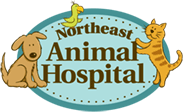Warnings and Recalls—Which Pet Foods Are Safe For Our Pets?

Northeast Animal Hospital has been keeping pet owners up-to-date on recent controversial trends in pet food. Our other article aims to help families understand the issues, along with some pet food brands recommended by our veterinarians. In this article, we want to share some thoughts for owners who still have questions about what they should feed their pets.
Between food recalls and constant changes in the understanding of pet food nutrition, like the recent finds that grain-free diets are not heart-healthy, it can be difficult to choose the right diet for your pet. It can also be frustrating to understand the nutrition labels of pet foods, to know how the ingredients have been processed, or why they’re nutritious. Then we have society telling us we should be eating organic, non-GMO, non-processed whole foods and fresh ingredients. As loving pet parents, we may extend our attitudes about what is healthy for our pets. Because of this, many pet parents are turning to raw food or homemade diets.
We’ve always cautioned away from recommending raw or homemade diets for pets, for many reasons. Raw diets carry the risk of bacteria, as pet foods and treats that include raw meat, organs, or meaty bones have been found to include parasites such as Toxoplasma and tapeworms, as well as the bacteria E-coli, Listeria, and Salmonella. One puppy that was on a raw diet of rabbit came into our practice with bloody diarrhea. A stool sample found a parasite in the puppy that is only found in rabbits. Homemade diets can lack proper nutrition if not carefully researched. (Homemade diets are sometimes necessary, however, when the pet has a medical condition that keeps them from eating commercially prepared diets, or the pet truly won’t eat the desired diet.)
We understand, though, that our clients want to know exactly what their pet is eating. So please understand that you can come to us for advice and we can help you make the best decision for the health and well-being of your pet. To help support you, we want to share some things you may want to think about before switching your pet’s diet.
- Any blog can post a recipe for pet food, but that doesn’t mean that it’s well-balanced and formulated correctly, which, if not, can be harmful to your pet. One study showed that 90% of homemade diet recipes were nutritionally inadequate. Pet food diets need the right balance of protein, fats, and fatty acids, carbohydrates, vitamins, and minerals. Then there’s the issue of how much of those things should the diet contain for your pet’s age and activity level. We highly recommend a consult with a pet dietary nutritionist from ACVN.org to find the right recipe for your pet’s needs. Here are some words of wisdom from them:
- “In general, home-prepared diets are more expensive than commercially available diets. Of course, they are also more time-consuming to prepare. There are many recipes for home-prepared pet diets available on the Internet and in books; however, the vast majority of these are inadequate and unbalanced. The recipes are either vague in instruction, contain errors or omissions in formulation, incorporate potentially problematic ingredients, or feature outdated strategies for addressing specific disease conditions. They may also lack specificity about the exact amount to feed a particular size of the pet. If you wish to prepare your pet’s food at home, consider getting a customized recipe and consultation with a board-certified veterinary nutritionist.”—ACVN.org
- If you decide to prepare a homemade diet for your pet, use a kitchen scale and measure in grams. Using cups as a unit of measurement can significantly alter the recipe depending on how finely you chop the ingredients.
- Make large batches so that you can freeze the food for those times you aren’t able to cook.
- Don’t substitute ingredients, such as replacing olive oil with coconut oil, without consulting an expert. This will change the formulation and nutrition of your diet.
- If you aren’t ready to cook your newly acquired recipe full-time for your pet, you can purchase freeze-dried raw or flash-pasteurized diets. Or consider combining a homemade diet with a veterinary therapeutic diet. You’ll also have the veterinary diet on hand if you run out of homemade.
- Every pet should have exams with full blood, urine, and stool testing every six months, but this is especially true for pets on raw or homemade diets.
- If feeding a raw diet, bear these safety measures in mind: Proper handling of the food, bowls, and resulting stools is needed to keep from spreading bacteria in those areas. But remember, your pet’s fuzzy face is in contact with potential bacteria and/or parasites, which can then be spread throughout the house and onto other people. At-risk groups, such as young children, the elderly, and people with compromised immune systems, are far more likely to develop illness if they come into contact with those types of infectious agents.
- If you decide that being your pet’s chef isn’t for you, you can still incorporate some fresh foods into their diet. Consider using fruit or veggies as treats, or add them to their usual meals. Be sure to research which foods to avoid feeding your pet. Click here for the ASPCA’s recommendations.
Finding the right diet for your pet is possible with a little patience and research. We are here to help answer any questions you may have.
